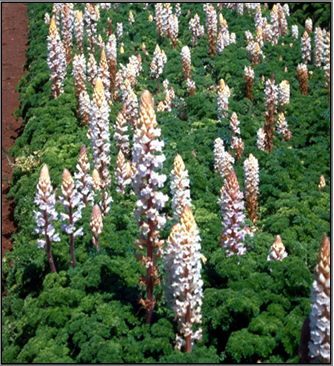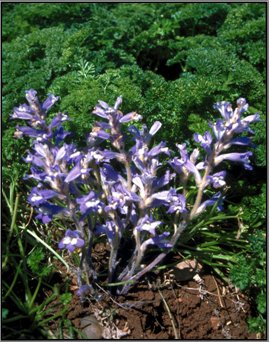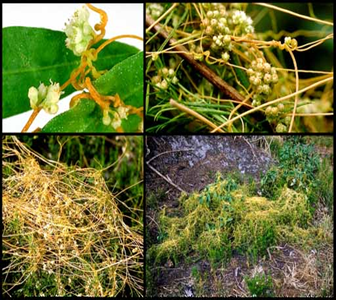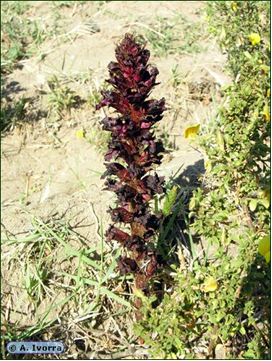Weeds - lentil
Contributors to this page: ICARDA, Aleppo, Syria (Siham Asaad, Abdulrahman Moukahal).
|
Contents: |
Broomrape, Branched Broomrape, Egyptian broomrape
Scientific names
Orobanche foetida Pers. and several other species: Orobanche crenata Forsk.,
Orobanche ramosa L, Orobanche aegyptiaca Pers.
Significance
Yield reductions of 30 to 70% are not uncommon. International markets may reject broomrape-contaminated produce.
Symptoms
The appearance of the parasite itself is the most diagnostic feature of infestation. The parasite has erect, branched or unbranched aerial flowering shoots. The leaves are reduced to scales and are disposed alternatively. The shoots bear bisexual tubular flowers in a spike. The tiny seeds are produced in enormous numbers in capsules.
Hosts
Broomrapes usually parasitic only broadleaved plants but there are a few records of attacks on monocots (grasses, etc.). Branched broomrape attacks many crops and common weeds. Crops attacked by branched broomrape around the world include: bean, broad bean, cabbage, capsicum (peppers), canola, carrot, cauliflower, celery, chickpea, clovers, eggplant (aubergine), flax, hemp (cannabis), hops, lentil, medics, onion, parsnip, paprika, pea, pyrethrum, sunflower, tobacco, tomato, potato.
Geographic distribution
Western and Central Asia (especially in Afghanistan, Syria, Egypt, India, Iran, Jordan, Lebanon, Morocco, Pakistan, Saudi Arabia, Australia, Europe (especially the Mediterranean), N. Africa, N. America.
Biology and transmission
Seeds germinate in moist soil at 18 to 23° C and require moist soil for one week to become established. The roots parasitic the roots of host plants for 40 to 50 days. Stems emerge in spring and are visible for only about 3 weeks from the end of September through to October. Flowering is rapid, within 6 to 9 days after stem emergence, with a similar period between the cessation of flowering and the ripening of fruit. An infestation may contain many plants that do not produce above-ground parts.
Dispersal from property to property and within properties in the infested area in South Australia appears to be mainly by carriage on vehicles and machinery. Seeds stick to equipment and animals that contact the plant and can also be dispersed by wind and water (including irrigation water/sprinklers), in animal manure, soil, fodder, on livestock and on footwear and clothing. Seeds attach to crop seeds and other produce. Seedlings imported from infested areas can carry seeds stuck to their leaves or in the soil. Seeds remain viable after passage through the digestive tracts of animals including cattle and goats.
Detection/indexing method at ICARDA
- Filter washing test
Treatment/control
-
Hand weed shoots prior to their seed formation to reduce inoculum levels. This is recommended in minor infestations only.
- Sow the crop late to help plants escape the worst effects of infection.
- Plow deep to bury Orobanche seeds into deeper soil layers to reduce infestation.
- Use selective herbicides such as imazaquin (10-15 ml a.i. /ha).
- Use soil solarization to reduce soil-borne inoculum.
- Use resistant varieties, if available.
Procedure followed at the centers in case of positive test
- Early field inspection and roguing, mechanical cleaning
References and further reading
http://www.icarda.org/Publications/Field_Guides/Lentil/Lentil.htm#Lent7.Html
|
Orobanche foetida (photo: ICARDA) |

Orobanche crenata (photo: ICARDA) |

Orobanche ramosa (photo: ICARDA) |

Orobanche egyptiaca (photo: ICARDA) |
Scientific names
Cuscuta campestris Yuncker and Cuscuta hyalina Roth.
Other scientific names
C. pentagona
Significance
The effect of field dodder on 12 legume crops was investigated in a greenhouse experiment. The legume crops showed great variations in response to field dodder parasitism. Based on the reduction in host dry weight (biological yield) caused by the parasite, lentil lost >50% of its biological yield was considered highly susceptible.
Symptoms
The appearance of the parasite itself is the best diagnostic symptom. It has fine, yellow or orange, thread-like branches which grow and entwine around the stems and other aboveground parts of the host.
Dodder-infected areas appear as patches in the field and continue to enlarge during the growing season. In late spring and early summer, dodder produces a massed cluster of white flowers.
Infected host plants become weakened, decline in vigor and produce poor yields.
Several patches might coalesce to form large areas that can be easily recognized by the yellowish color of the parasite strands.
Hosts
It is the most important Cuscuta species, attacking a wide (C. campestris) range of species, including vegetables, fruits, ornamentals and woody plants. It is reported as a weed in 25 crops in 55 countries.
Geographic distribution
Europe to North Africa and eastern Asia
Detection/indexing method in place at the CGIAR Center at ICARDA
- Filter washing Test
Treatment/control
- Dodder is best controlled through establishment prevention by using clean seed. Ornamental beds should be kept clean of seed-producing plants. Once dodder becomes established, eradication is almost impossible. Mechanical removal can be attempted, but once dodder has produced the haustoria it is near impossible to avoid damage to the host plant. If dodder has germinated and has attached to a host plant, removal of both is recommended to eradicate.
- Use of pre-emergent herbicides is the best chemical approach. These products must be applied prior to the germination of the seed as the small seedling root will drop off once the haustoria has formed. Dinitroanaline herbicides have been reported to be effective. Dichlobenil has also shown good results. Read all labels to ensure that the herbicides can be used around the host plants. Glyphosate has shown results as a postemergent herbicide, but its use is limited as it will also damage the host plant. Phenoxy herbicides have only shown limited control and again injury to the host plant can occur.
Procedure followed at the centers in case of positive test
- Early field inspection and roguing, mechanical cleaning
References and further reading
http://www.icarda.org/Publications/Field_Guides/Lentil/Lentil.htm#Lent7.Html
http://www.weedalert.com/weed_pages/wa_dodder.htm

Cuscuta hyalina (photo: ICARDA) |

Cuscuta campestris (photo: ICARDA) |
Comments
- No comments found






Leave your comments
Post comment as a guest